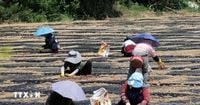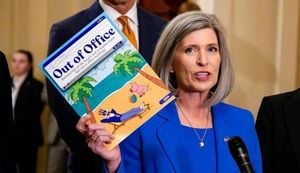On August 30, 2025, South Korea found itself grappling with a crisis that many residents in the eastern city of Gangneung had feared for weeks: a severe drought so dire that President Lee Jae Myung formally declared a national disaster. According to Yonhap News Agency, this move came after months of dwindling rainfall and rapidly declining water reserves, leaving officials with little choice but to act swiftly and decisively.
The president’s declaration wasn’t a mere formality. It marked a rare and urgent mobilization of government resources, all aimed at supporting Gangneung and its struggling residents. President Lee, speaking through his spokesperson Kang Yu Jung, directed all relevant ministries to take immediate action. “President Lee has ordered concerned ministries to act at once and mobilize firefighting forces to support areas affected by the drought in Gangneung,” Kang told Yonhap. The message was clear: the government would do whatever it took to blunt the disaster’s impact and ease the burden on ordinary people.
But what set this crisis apart wasn’t just the official response—it was the scale of the drought itself. Gangneung, located in Gangwon province on South Korea’s eastern coast, had seen only half its usual rainfall over the past six months, according to government data cited by VietnamPlus. This shortfall, coupled with persistent heatwaves, pushed the city’s main water supply to a record low. By August 29, the water reservoirs that provide drinking water to much of Gangneung had plummeted to just 15.7% of their normal capacity, a level described by local officials as unprecedented.
The severity of the drought prompted the Gangwon provincial government to formally request that the national government declare a disaster, a proposal that President Lee acted upon the very same day. He didn’t stop at declarations, though. Lee convened an emergency meeting with top officials to hammer out a coordinated response. The stakes were high: not only was Gangneung’s water supply at risk, but the city’s residents were facing mounting inconveniences as taps ran dry and daily routines were upended.
To address the immediate crisis, officials announced that 50 water tank trucks from the fire department would be dispatched to Gangneung, with plans to deliver an extra 2,000 tons of water every day. The logistics alone were daunting, but the government insisted it was prepared to marshal all available resources. “The president has instructed the government to mobilize every possible resource to minimize the impact of the drought and reduce inconvenience for citizens,” spokesperson Kang Yu Jung reiterated, as reported by Yonhap.
For many Gangneung residents, the government’s response offered a glimmer of hope amid growing anxiety. Local businesses and households had been rationing water for weeks, and some neighborhoods reported running out entirely. The additional water shipments, while not a permanent fix, promised at least some relief as officials worked on longer-term solutions.
This crisis didn’t occur in a vacuum. South Korea has experienced a series of unusual weather patterns throughout the summer of 2025. Just two weeks before the disaster declaration, a heatwave warning was reissued for Seoul and much of central South Korea on August 15, barely a week after a previous warning had been lifted in the capital. According to VietnamPlus, these recurring heatwaves have compounded the drought’s effects, further straining water supplies and increasing demand among residents desperate to stay cool.
Experts point to a confluence of factors behind Gangneung’s predicament. Climate scientists, drawing on recent rainfall data, note that the city’s precipitation over the past six months was only half the annual average—a dramatic shortfall that left reservoirs unable to recharge. The persistent heatwaves only made matters worse, accelerating evaporation and driving up water consumption. For those who follow climate trends in the region, the situation in Gangneung is a stark reminder of the vulnerabilities facing many communities as weather patterns grow more erratic.
The government’s rapid response, while commendable, also highlighted the challenges of disaster management in a changing climate. Mobilizing 50 water tankers and coordinating daily deliveries of 2,000 tons of water is no small feat, especially when roads and infrastructure may already be strained by the heat. Yet, as President Lee made clear, the alternative—leaving residents without water—was simply unacceptable.
“We are committed to doing everything possible to support Gangneung and its residents during this difficult time,” Lee said during the emergency meeting, according to Yonhap. He emphasized the need for both immediate relief and longer-term strategies to address water shortages, signaling that the government would continue monitoring the situation closely and adapt its response as needed.
For Gangneung, the drought has become a test of resilience. The city, known for its scenic coastline and vibrant cultural life, now finds itself at the center of a national emergency. Local officials have urged residents to conserve water wherever possible and have begun exploring additional measures to safeguard the city’s remaining supplies. Meanwhile, the deployment of water tankers has become a daily ritual, with firefighters and volunteers working around the clock to ensure that every neighborhood receives at least some relief.
The drought’s impact has also sparked broader conversations about South Korea’s preparedness for future climate-related disasters. Some policy experts have called for greater investment in water infrastructure and more robust early warning systems, arguing that the crisis in Gangneung could be a harbinger of similar challenges elsewhere. Others have pointed to the need for stronger coordination between local and national authorities, particularly as weather events become more unpredictable.
In the coming weeks, much will depend on whether the rains return and whether emergency measures can keep pace with demand. For now, the people of Gangneung are adapting as best they can, drawing on community spirit and the promise of government support. As President Lee’s declaration makes clear, the crisis has become a national concern—one that will require sustained effort, innovation, and perhaps a bit of luck to overcome.
As the water tankers roll into Gangneung and officials race to stabilize the situation, South Korea is reminded once again of nature’s power—and the importance of readiness in the face of adversity.




